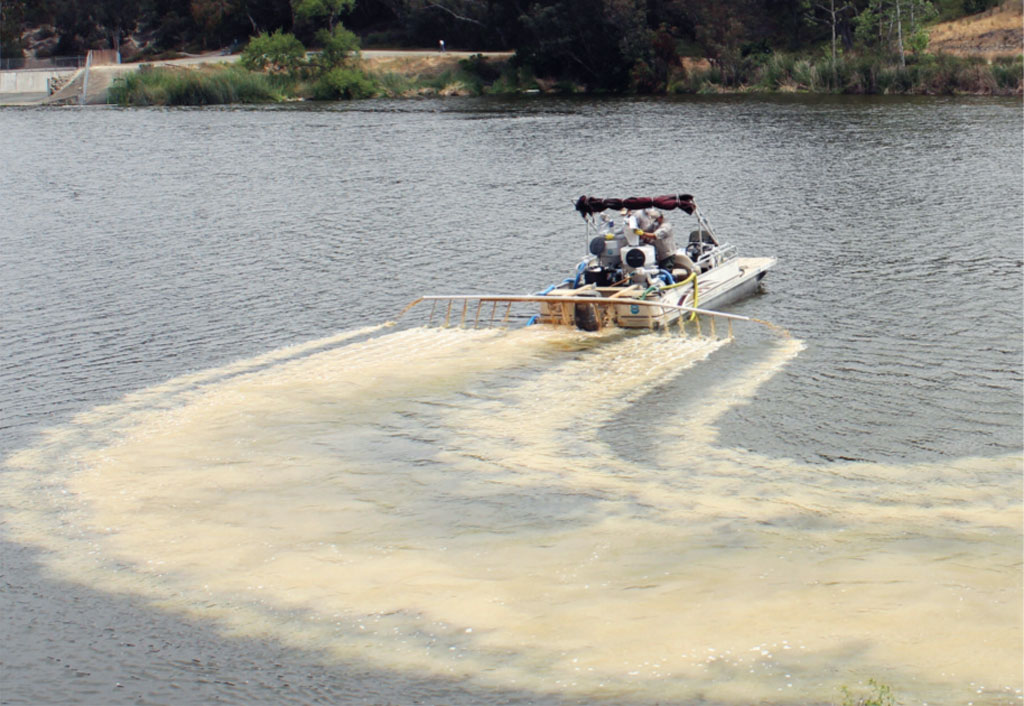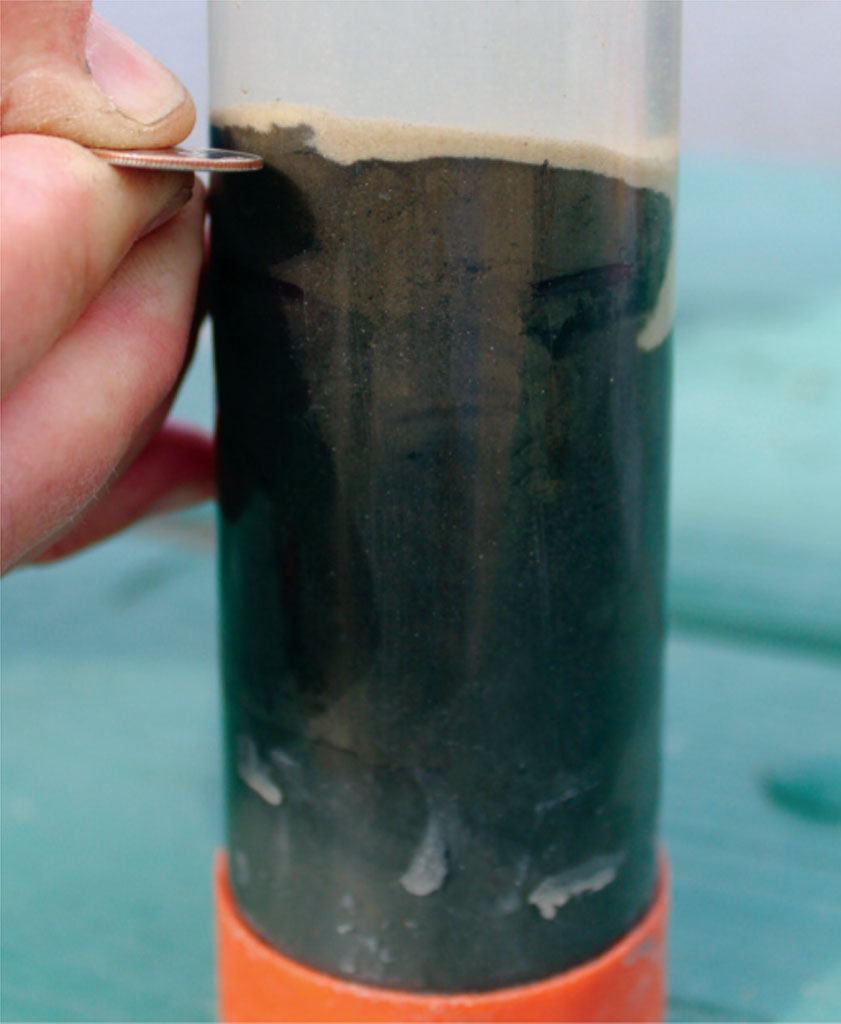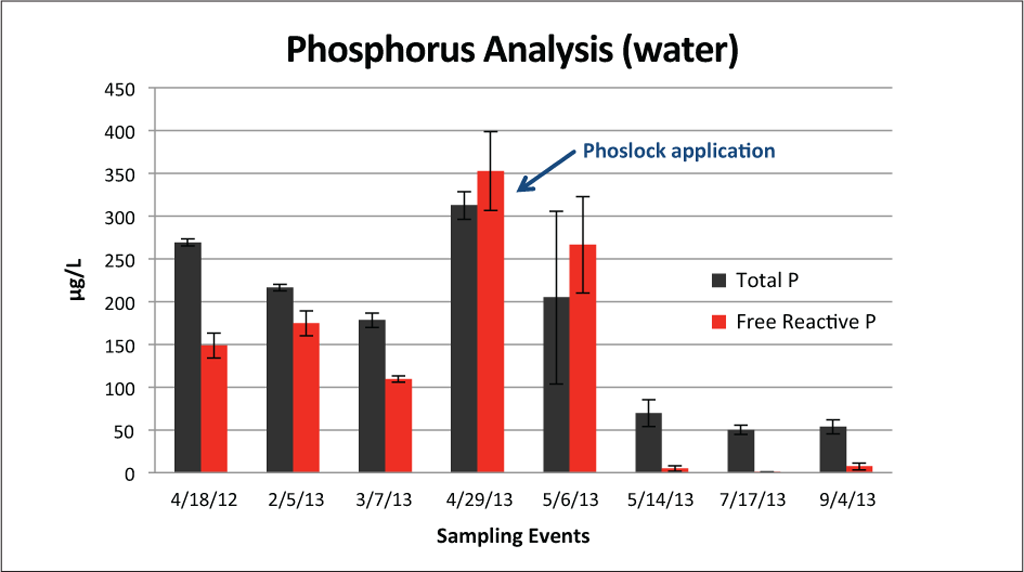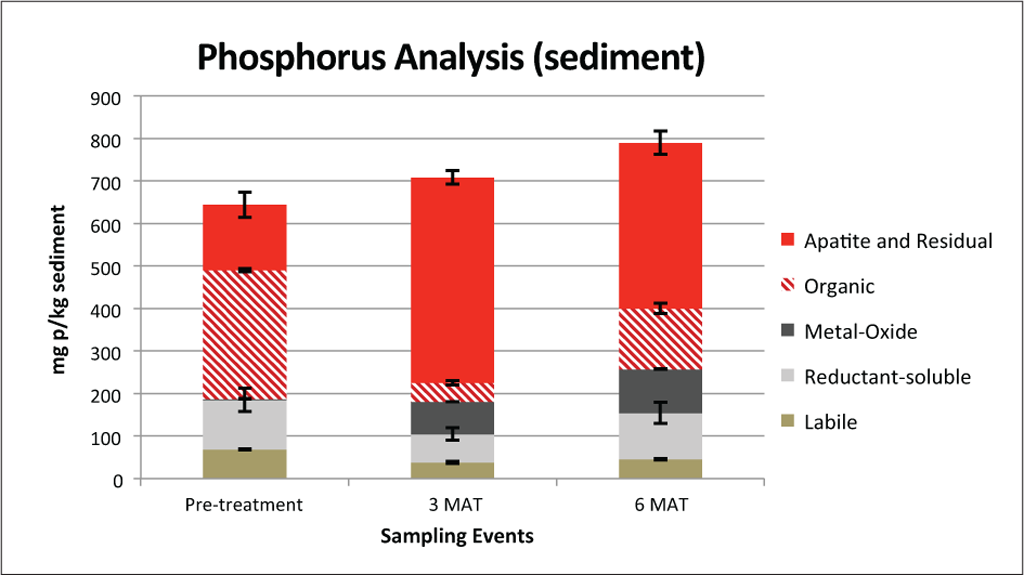Water Quality Restoration
In Laguna Niguel Lake
Project Overview
Location: Orange County, California
Lake: 31 surface acres, 12 feet average depth
Management Objective: Address eutrophication and restore water quality by reducing in-lake phosphorus pollution.
Solution: Application of Phoslock® phosphorus locking technology
Results: Significant and sustained reduction in phosphorus concentrations, shift of mobile to stable phosphorus fractions in the bottom sediments and improved water quality.
The Problem
Laguna Niguel Lake (Sulfur Creek Reservoir) is a focal point and recreational resource for the park patrons and surrounding community. Since 2009, Orange County Parks (OC Parks) and their lake management consultant, Aquatechnex LLC, have reported an alarming decline in overall water quality of the lake. The installation of aeration in 2010 and routine algae maintenance was not resulting in the desired improvement for OC Parks and the public. The primary concern here is the hyper-eutrophic status (excessive phosphorus) of the lake and resultant toxic algae blooms. These blooms could pose negative impacts to human health and aquatic life.
The Solution
Although nurtient inputs from the inlet creek and surface runoff contribute to the annual load of phosphorus into the lake, monitoring of the water and lake sediments in recent years suggested internal phosphorus loading as a significant contributor to the water quality issues experienced in this lake. In 2013, Auatechnex LLC and OC Parks implemented a phosphorus mitigation strategy to inactivate available forms of phosphorus in the water column and break the internal phosphorus loading cycle of the sediments. Phoslock phosphorus locking technology was applied to the lake over a three day period (April 29 to May 2, 2013) to strip available forms of phosphorus (i.e. free reactive or othrophosphate) from the water and inactivate the potentially mobile or bioavailable forms from in lake sediments. Global Positioning System (GPS) technology was used on the applications boats to assure targeted application of necessary Phoslock amounts throughout four treatment zones encompassing the entire water body (Figures 2 & 3). Phoslock dosing in each zone was based on surface area, water depth, sediment characteristics and phosphorus concentrations.
Monitoring
Periodic water quality analyses were conducted from three water column lake samples in 2012 and 2013. Samples were taken before Phoslock application and post-treatment through September 2013.
Benthic macroinvertebrate sampling and assessment were conducted both upstream and downstream of the lake immediately before treatment (4/29/13) and 4 days after Phoslock application completion (5/6/13).
In addition, lake sediment samples were collected from 3 sites in the lake using a threaded stainless steel coring apparatus. Sediment samples were taken prior to the Phoslock application (4/29/13); and 3 and 6 months post treatment (8/7/13; 12/4/13)(Figure 4). The top 5 cm layer of sediments (2 samples homogenized composite) from each sample location were sent to the laboratory for analysis. Sequential extraction was used to determine relevant phosphorus fractions and compare concentrations of bioavailable and stable phosphorus forms prior to and following the treatment.
The Results
No significant changes were measured in pH, turbidity, conductivity and alkalinity during and after the application. However, phosphorus rapidly (< 2 weeks) and significantly (p < 0.0005) decreased the total (> 80%) and free reactive phosphorus (> 95%) in the water column (Figure 5). Both total and free phosphorus concentrations remained low (< 54 ug/L and < 7ug/L, respectively) for the 5 months of monitoring post application. Sediment sampling from three in-lake locations documented the inactivation of potentially releasable sediment phosphorus fractions, thus significantly increasing (23.9% to 52.5%) the mass of more stable phosphorus fractions (apatite and residual) in 6 months post-treatment (Figure 6).
Secchi depth greatly increased post Phoslock application with an average of 122 cm from April – September 2013, where the corresponding timeframes measured 62 and 101 cm in 2011 and 2012, respectively.
Prior to the Phoslock application, the algal assemblage was dominated by cyanobacteria which historically persisted from March to October. Sampling conducted one month prior to the Phoslock application documented the algae assemblage to again be dominated by cyanobacteria (primarily Aphanizomenon flos-aquae) with an average density of 33,300 cells/mL. Following the Phoslock application and subsequent reduction of available phosphorus, the main species of algae shifted to green algae and diatoms (average 6,000 cells/mL; Figure 7). Cyanobacteria concentraions fell significantly to an average of 1,200 cells/mL. Cyanobacteria levels remained below or near detection limits throughout this study.
In previous years, reactive algaecide applications were required on a routine basis to maintain the desired aesthetic quality of the lake. Since May 2013, no noticeable cyanobacteria scum formations were observed and for the first time in years, no reactive algaecide applications targeting cyanbacteria were required to sustain desired algae and water quality conditions. The monitoring also documented no significant composition or diversity alteration to the adjoining stream benthic macroinvertebrate community after the Phoslock application.
Periodic water quality monitoring is scheduled for 2014 by OC Parks and Auatechnex LLC and updates on this project will be provided in the future.
Conclusion
Phoslock significantly decreased and sustained lower concentrations of phosphorus in the water column. The application also shifted sediment phosphorus fractions from potentially bioavailable to highly stable forms compared to pre-treatment concentrations. Consequently the algal assemblage shifted from historic cyanobacteria dominated blooms, to low levels of non-problematic green algae/diatoms. The resulting water quality and clarity improvements also allowed submersed macrophyte growth (widgeon grass) for the first time in nearly 10 years.
Phoslock provided the water resource managers and public who enjoy Laguna Niguel Lake an ecologically sound in situ solution to address phosphorus pollution and restore water quality.
Project Images

Figures 2 & 3: Phoslock application to Laguna Niguel Lake.

Figure 4: Sediment cored sample collected after Phoslock application to Laguna Niguel Lake.

Figure 5: Phosphorus concentration average, from three in-lake water sampling locations. Error bars represent one standard deviation.

Figure 6: Phosphorus concentration averages, prior to and after Phoslock application, from three in-lake sampling locations. Error bars represent one standard deviation.

Figure 7: Algae assemblage composition at different sampling events in Laguna Niguel Lake. Values are averages from the same three sampling locations as the other water quality parameters.
